TORTRICIDAE - Cydia pomonella (Linnaeus) *Non-Rep*
Taxonomy
Tortricoidea: Tortricidae: Olethreutinae: Grapholitini: Cydia pomonella (Linnaeus)
Common names: codling moth
Synonyms: Tortrix aeneana, C. splendana glaphyrana, Pyralis pomana, Tortrix pomonana, C. pomonella simpsonii
Cydia pomonella is often referred to as Carpocapsa pomonella or Laspeyresia pomonella in older literature.
The correct generic name is Cydia; refer to Brown (2006) for more information.
Larval diagnosis (Summary)
- D2 setae on A9 on the same pinaculum
- D1 and SD1 setae on A9 on the same pinaculum
- Usually with distinct pattern/mottling on the anal and prothoracic shields in mid- to late instars
- A9 trisetose, often with the ventralmost L seta on a separate pinaculum
- Abdominal prolegs with 25-35 crochets
- Anal comb absent
- Larva an internal feeder on Rosaceae or Juglandaceae
Host/origin information
Due to its cosmopolitan distribution, larvae of C. pomonella are intercepted from origins throughout the world. Approximately 40%
of all interceptions originate in Mexico; other common origins are listed below:
| Origin |
Host(s) |
| Armenia | (various) |
| Canada | (various) |
| Mexico | Cydonia, Malus, Prunus, Pyrus |
| Russia | (various) |
| Ukraine | (various) |
Recorded distribution
Cydia pomonella is found in nearly all temperate pome fruit-growing regions of the world. It is notably absent from Japan and Korea (Barnes 1991).
Identification authority (Summary)
Morphological variaton makes a species-level diagnosis difficult in some instances. It is safest to restrict positive identifications to
larvae intercepted on Rosaceae or Juglandaceae that exhibit a combination of the "typical" C. pomonella characters listed above.
Pest characterization
- Taxonomy: High. Species-level identification is usually possible.
- Low: Low. Cydia pomonella is present (and common) throughout the U.S.
- Potential Impact: High. Cydia pomonella is a pest.
This ranking characterizes C. pomonella as not quarantine significant for the U.S.
TORTRICIDAE - Cydia pomonella (Linnaeus) *Non-Rep*
Larval diagnosis (Detailed)
Brown (2011) divided intercepted tortricid larvae into four "types." Larvae of C. pomonella are grouped
under the "Cydia type" with D1 and SD1 on the same pinaculum on A9, the L group on T1 not extending beneath the
spiracle, and an anal comb absent. He used the following characters to identify larvae of C. pomonella:
D2s on A9 always on same pinaculum; SV group counts usually 3:3:2:2:1; usually (but not always) with distinct
pattern on anal and prothoracic shields; A9 with ventralmost L seta on a separate pinaculum; 30-35 crochets; mostly on Rosaceae.
MacKay (1959) included C. pomonella as the only member of her "Carpocapsa, Group 5." She listed the following
characters as the most important: head with a rounded ocellar area and acute vertical angle; spinneret slender and tapered;
basal segment of labial palp stout; pinacula moderately large; SD1 on A8 anterior or slightly anteroventral to the spiracle;
anal fork [comb] absent.
Kolmakova (1958) described the larva of C. pomonella as being whitish, cream or slightly pink. In addition, the codling moth does
not have a very deep notch on the head compared to Grapholita. This is correlated with MacKay's (1959) comments on the vertical angle.
Both Okumura (1965) and Weisman (1987) gave characters to separate C. pomonella from the very similar C. latiferreana that may be
intercepted from Canada or Mexico. The mandible of C. pomonella tends to be more square than rectangular; the opposite is true
for C. latiferreana. Spacing of the metathoracic coxae and V setae are also different. The codling moth has the metathoracic coxa
separated by about the diameter of each coxa and the V1 seta almost touches the coxal base. The separation of the coxae is
approximately 1.5 times the diameter of each coxa for C. latiferreana and the V1 seta is well seperated from the coxal base.
Weisman (1987: fig 33a, b) illustrated these characters.
Unfortunately, many of the characters traditionally used to diagnose larvae of C. pomonella are extremely variable. Internal feeders
tend to have pinacula that are weakly sclerotized, thus it may be difficult to distinguish if the D2 setae on A9 are on the same
pinaculum. Brown (2011) handled this problem by including another couplet leading to C. pomonella that stated: "D2s on A9
on separate or same pinacula." SV group counts are also variable, with 3:3:2:2:1 being the usual state (Brown 2011), but the combinations
3:3:2(1):1:1, 2:3:2:2:1, or 3:3:2:2:2 have also been observed (Gilligan and Epstein 2012, MacKay 1959). Many "typical" larvae
have a distinct mottled pattern on the anal and prothoracic shields, but some individuals have no markings on either shield. The trisetose
L group on A9 is a useful character, especially when the ventralmost L seta is on a separate pinaculum; however, all three setae
can be routinely found on the same pinaculum. The most reliable larval character may be the crochets on the abdominal prolegs,
which range in number from 25 to 35 (Wearing et al. 2001). Because of the morphological variation within C. pomonella,
identification of larvae that do not exhibit a combination of the "typical" character
states may be difficult or impossible to positively identify without other evidence (such as molecular diagnostics).
A young larva with a dark head, dark prothoracic shield without a pattern, and pink body was illustrated by Passoa (2008).
Other similar tortricid species include Grapholita and Cydia splendana. Larvae of C. pomonella can be distinguished from
most Grapholita by the absence of an anal comb. Larvae of C. splendana have fewer crochets on the abdominal prolegs (15-20),
lack the distinctive mottling on the anal and prothoracic shields, and are usually found on Fagaceae (especially Castanea)
(Wearing et al. 2001).
Identification authority (Detailed)
Because C. pomonella is a common cosmopolitan species, origin information is not useful for identification. Host is much more helpful,
although individuals have been reported from non-traditional hosts such as Citrus (and others listed in Wearing et al. 2001).
We can confirm Rutaceae as a potential larval host based on C. pomonella larvae found on imported Citrus in 2009 and identified using DNA barcoding.
Morphological variaton makes a species-level diagnosis difficult in some instances. It is safest to restrict positive identifications to
larvae intercepted on Rosaceae or Juglandaceae that exhibit a combination of the "typical" C. pomonella characters (D2s on A9 on the same
pinaculum; distinct pattern/mottling on the anal and prothoracic shields; A9 trisetose, often with the ventralmost L seta on a separate pinaculum;
abdominal prolegs with 25-35 crochets; anal comb absent). Individuals from Rosaceae that lack patterning on the anal and prothoracic shields but
possess a combination of the other characters listed here are also likely C. pomonella. Individuals from non-traditional hosts or with
non-typical morphology may need to be left at genus or confirmed using molecular methods. Cydia pomonella is an internal feeder, thus leaf rollers, other leaf
feeders, or web makers can normally be eliminated as codling moth suspects.
TORTRICIDAE - Cydia pomonella (Linnaeus) *Non-Rep*
Origin records
Cydia pomonella has been intercepted from the following locations:
Albania, Argentina, Armenia, Austria, Azerbaijan, Azores, Belarus, Bolivia, Bosnia and Herzegovina, Brazil, Bulgaria,
Cameroon, Canada, China, Costa Rica, Croatia, Czech Republic, Denmark, Dominican Republic, Ecuador,
Egypt, France, Germany, Greece, Guatemala, Hungary, India, Iran, Iraq, Israel, Italy, Jordan, Kazakhstan,
Kyrgyzstan, Lebanon, Lithuania, Macedonia, Mexico, Moldova, Morocco, Netherlands, Peru, Poland, Portugal,
Romania, Russia, Serbia, Serbia and Montenegro, Slovakia, Slovenia, Spain,
Sweden, Switzerland, Syrian Arab Republic, Turkey, Ukraine, United Arab Emirates,
United Kingdom of Great Britain and N. Ireland, Uzbekistan, Yugoslavia
Host records
Cydia pomonella has been intercepted on the following hosts:
Ananas comosus, Annona cherimola, Capsicum sp., Carya sp., Castanea sativa,
Castanea sp., Cattleya sp., Chilopsis linearis, Corylus avellana, Crataegus monogyna, Crataegus sp.,
Cydonia oblonga, Cydonia sp., Juglans nigra, Juglans regia, Juglans sp.,
Malus domestica, Malus sp., Malus sylvestris, Opuntia sp., Passiflora sp., Pinus sp.,
Prunus americana, Prunus armeniaca, Prunus avium, Prunus domestica, Prunus persica,
Prunus persica var. nucipersica, Prunus sp., Punica granatum, Pyrus communis, Pyrus pyrifolia,
Pyrus sp., Pyrus ussuriensis, Quercus sp., Rosaceae
Although not listed in PestID, larvae were intercepted on Citrus in 2009, confirming Rutaceae as a potential larval host.
TORTRICIDAE - Cydia pomonella (Linnaeus) *Non-Rep*
Setal map
 Cydia pomonella setal map Cydia pomonella setal map
<< Previous fact sheet Next fact sheet >>
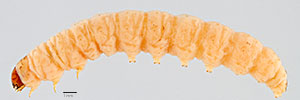 Fig. 1: Late instar, lateral view
Fig. 1: Late instar, lateral view |
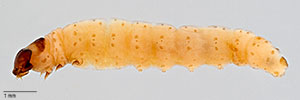 Fig. 2: Late instar, lateral view
Fig. 2: Late instar, lateral view |
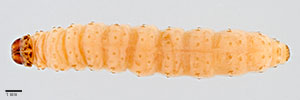 Fig. 3: Late instar, dorsal view
Fig. 3: Late instar, dorsal view |
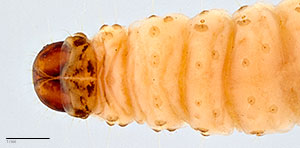 Fig. 4: Head and prothoracic shield (note markings), dorsal view
Fig. 4: Head and prothoracic shield, dorsal view |

Fig. 5: L group on A9 |
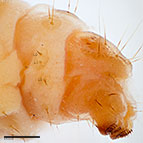
Fig. 6: L group on A9 |
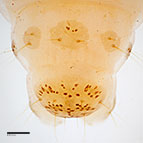 Fig. 7: A9 dorsal view and markings on anal shield
Fig. 7: A9, anal shield |
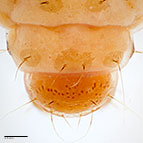 Fig. 8: A9 dorsal view and markings on anal shield
Fig. 8: A9, anal shield |

Fig. 9: Crochets |

Fig. 10: Head |
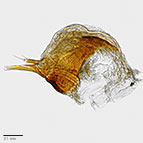 Fig. 11: Hypopharyngeal complex, lateral view
Fig. 11: Hypo. complex |

Fig. 12: Mandible |
|
|
|
|
|